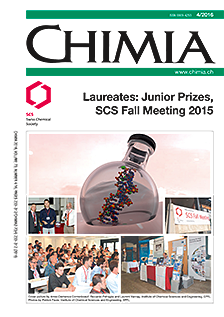PH3 as a Phosphorus Source for Phosphinidene–Carbene Adducts and Phosphinidene–Transition Metal Complexes
DOI:
https://doi.org/10.2533/chimia.2016.279Keywords:
Carbene insertion, N-heterocyclic carbenes, Phosphine gas ph3, Phosphinidene complexes, Transition metal complexesAbstract
The parent phosphinidene–carbene adduct NHC=PH is a versatile synthon in main group chemistry and can act as an electronically flexible ligand for transition metals. Previously, it could only be synthesized with sterically demanding N-aryl substituents. This paper describes simple methods for the synthesis of NHC=PH adducts with varying steric demand from elemental phosphorus or easily accessible phosphorus sources. Furthermore, the reactivity of NHCs towards PH3 was investigated. It was shown how a NHC inserts into the P–H bond of PH3, which opens up a route to NHC=PH adducts from an imidazolium salt and PH3. The adducts were used in the simple syntheses of bis(phosphinidene) mercury(II) and group 6 pentacarbonyl parent phosphinidene complexes. Their electronic and structural properties were investigated to elucidate the influence of the NHC on the phosphinidene and identify possible applications.Downloads
Published
2016-04-27
Issue
Section
Scientific Articles
License
Copyright (c) 2016 Swiss Chemical Society

This work is licensed under a Creative Commons Attribution-NonCommercial 4.0 International License.
How to Cite
[1]
M. Bispinghoff, H. Grützmacher, Chimia 2016, 70, 279, DOI: 10.2533/chimia.2016.279.







